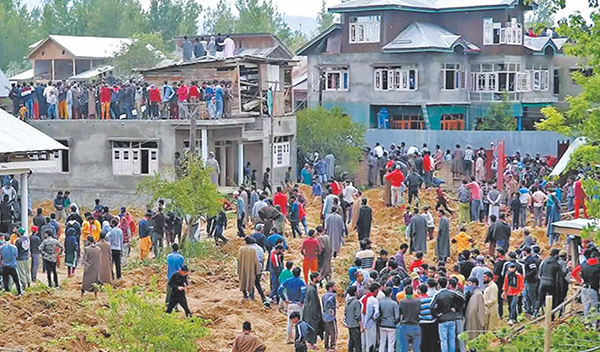
The whole world has been feverishly battling the Covid-19 pandemic. Not Pakistan. It saw in the pandemic a crass opportunity to push its asymmetric warfare agenda. In April alone 18 of our security personnel laid down their lives fighting the terrorists. These included a Colonel and a Major. Pakistan has stepped up ceasefire violations, infiltration attempts and terrorist attacks in Kashmir. The security forces have also hit back eliminating two key terrorist commanders (including Riaz Naikoo, divisional commander of Hizbul Mujahideen) in quick succession.
But that will not be adequate. Pakistan had been clearly warned not to escalate the terror graph. India had retaliated with a surgical strike after an attack at Uri. For a few months Pakistan was relatively subdued. Then it got over the shock and resumed terror violence. After Pulwama, in February 2019, India retaliated with an air strike across the international border. This seriously rattled Pakistan and for almost a year there was relative dormancy in the terror offensive. The abrogation of Article 370 in J&K also passed off without major incidents in this interlude. Now Pakistan seems determined to break the status quo in J&K.
Somehow, the Deep State in Pakistan thought that India and the rest of the world were too preoccupied with the Covid pandemic. Pakistan’s Inter-Services Intelligence (ISI) sensed a crass opportunity and stepped up the violence rather steeply. The Line of Control (LC) was activated in a major way. India retaliated with fire assaults in the Neelam Valley and Poonch. These destroyed an ammunition dump, an artillery battery and a terror camp. 50 Pakistani soldiers and terrorists were killed. Pakistan retaliated by upping the ante in the Valley with a series of attacks on security forces.
Afghan Connection. The ceasefire in Afghanistan is in tatters. The ISI is planning a big push to overthrow the government in Kabul. Recently, the Afghan security forces busted a Jaish-e-Mohammed (JeM) camp being run under the aegis of the Taliban. The captured terrorists revealed that the JeM was running seven terror camps inside Afghanistan. The plan was to gain operational experience and then push some 400+ battle-hardened Jaish and Lashkar-e-Toiba (LET) cadres into Kashmir to escalate the level of violence.
Way Ahead. India had clearly indicated to Pakistan that it should now expect strong retaliation across the LC for any mass casualty terror attacks. India would exercise the right to hot pursuit and raise costs and consequences for the Deep State in Pakistan. It would not be a one-way street any longer. So frankly, India will now have to respond unless it wants the new deterrence regime to break down completely.
Quite obviously deterrence has not worked and we have to go at least two-three levels up the escalation ladder. And should that result in a limited war a la Kargil, so be it.
Covid-19 Pandemic
Covid-19 pandemic has seriously affected the global economy. The Pakistani economy was close to collapse even before the pandemic. The collapse of oil prices will seriously impact the capacity of its Middle East patrons to bail it out. China’s Belt & Road Initiative (BRI) is fast turning into a serious liability with the pandemic. If India is able to kick-start its economy quickly, it could well effect a sharp V-shaped recovery next year. The Pakistani economy can ill afford a conflict right now. One nudge now cold push it over the edge in the post-pandemic period this nuisance of a nation will collapse without a shot being fired.
Recovery Plan. India enforced a relatively early and very strict lockdown in March 2020 itself when we had just 500 casualties. It has now been on for some 45 days plus. The aim was to control the spread of infections and gain time to build up the requisite medical infrastructure to deal with large scale spread of infection. That has largely been done. The simple but unfortunate calculus is that each day of the lockdown now enhances the economic costs and consequences. It has derailed our hospitality and aviation sectors completely and seriously dislocated the industry. Demand is virtually zero. If we do not resume economic activity immediately, our micro, small and medium enterprise (MSME) sector could suffer irreparable damage.
Massive layoffs and unemployment can generate serious social unrest. The migrant labour problem seems to have taken us by surprise, by its sheer scale. Though the government and NGOs did step in to feed the migrants – it has not been as successful as it was thought to be.
We have to restore the supply chain and logistics. Our morbidity and mortality rate is relatively low. Countries that have suffered over 50,000 casualties are opening up their economies. India has some 300 districts with no cases and an almost equal number with a mere 5-10 cases. We need to open up urgently and kick start our economy on an emergent basis and remove the choke-holds on both supply and demand. Paradoxically, while Covid-19 presents a huge challenge, it is also a major opportunity. Many countries are planning to move their basic industries out of China and rework the global supply chains. It is time for bold and decisive actions to attract them.

















